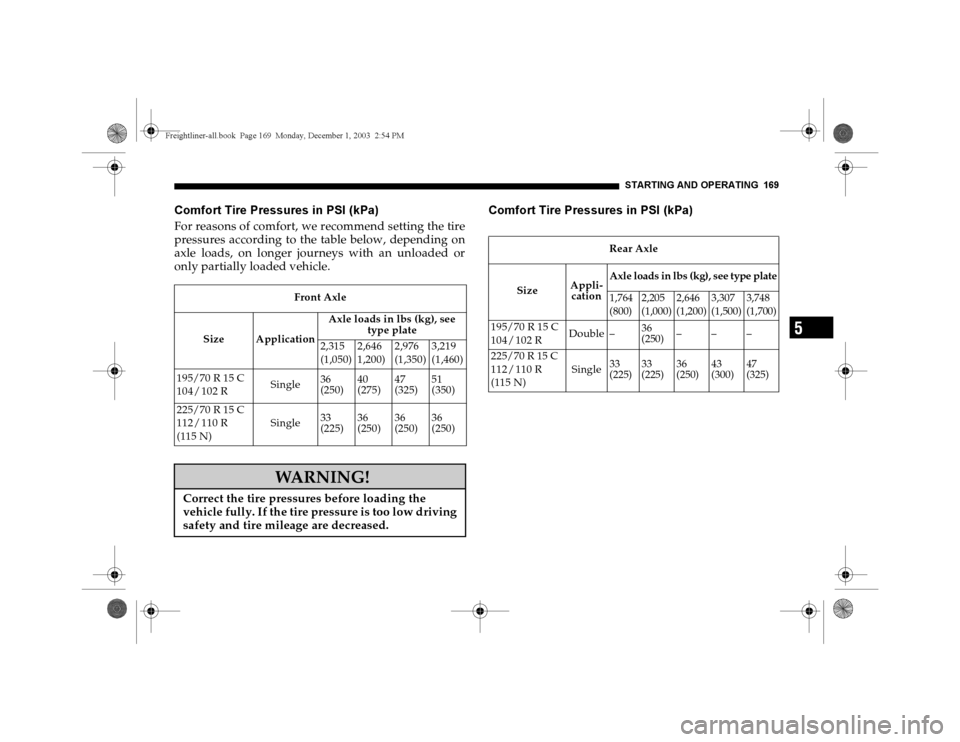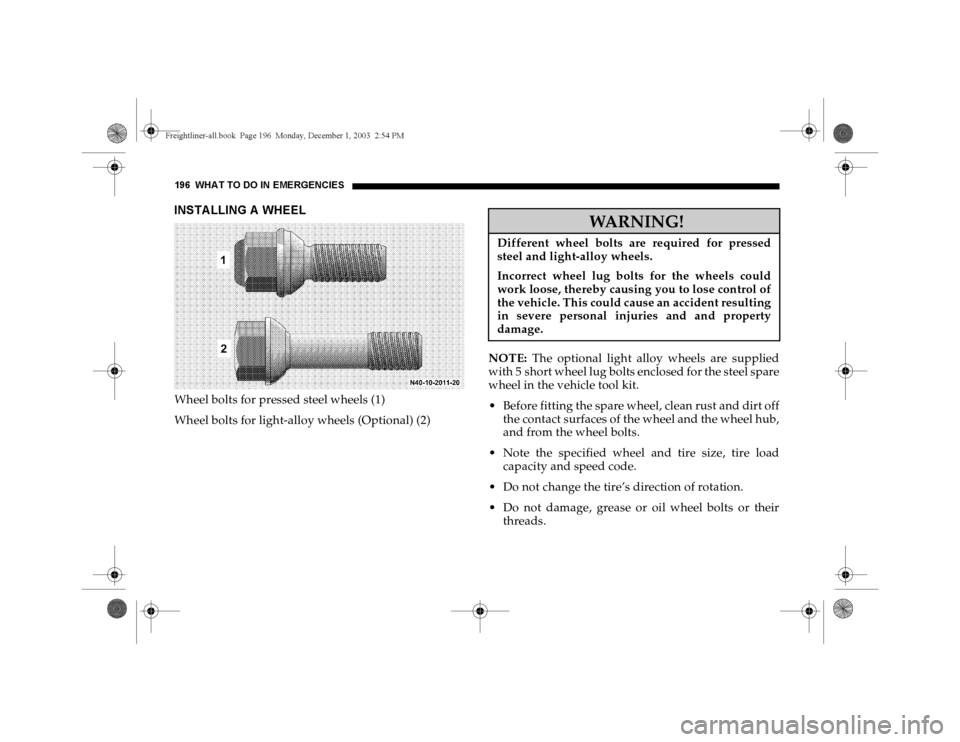2004 DODGE SPRINTER tire size
[x] Cancel search: tire sizePage 158 of 272

158 STARTING AND OPERATINGA cceleration Skid Control (A SR)ASR makes it possible to pull away and accelerate on a
slippery surface. A spinning wheel is braked and its
tractive power is transferred to the wheel with full
grip.
The acceleration skid control (ASR) improves driving
stability at all speeds only on vehicles of the chassis
and cargo/passenger vans type 3500 C/HC/SHC
(without ESP).
The engine’s torque is limited to improve driving
stability. When this is happening, the warning
lampv in the speedometer flashes.
If the road surface is not capable of providing traction,
bearing in mind the tires, load and grade, it may not be
possible to pull away even with ASR.
If wheels with tires of a different size than those offered
by an authorized Sprinter Dealer are used, the correct
operation of the ASR cannot be guaranteed.
WARNING!
ASR cannot prevent the natural laws of physics
from acting on the vehicle, nor can it increase the
traction afforded.
The ASR cannot prevent accidents, including
those resulting from excessive speed in turns,
following another vehicle too closely, or
hydroplaning. Only a safe, attentive, and skillful
driver can prevent accidents.
The capabilities of an ASR equipped vehicle must
never be exploited in a reckless or dangerous
manner which could jeopardize the user’s safety
or the safety of others.
If the ASR function is used for a prolonged period
of time, the rear axle brakes may fail due to
overheating.
If the vehicle is to be towed away with the front
wheels clear of the ground, or if the brakes are to
be tested on a brake dynamometer, do not pull the
key in position 2 in the ignition lock, because the
drive wheels could lock.
Freightliner-all.book Pag e 158 Monday, December 1, 2003 2:54 PM
Page 162 of 272

162 STARTING AND OPERATINGNOTE: If the ABS is malfunctioning or the voltage in
the vehicle’s electrical system drops below 10 volts, the
indicator lamp will also light up in the instrument
cluster and the ESP will be deactivated. The indicator
lamp will go out as soon as the voltage reaches this
level again or the ABS is operational again
– the ESP is
then reactivated.
Electronic Stability Program (ESP) (Cargo/
passenger vans type 2500 C/HC/SHC only)The Electronic Stability Program (ESP) monitors the
vehicle’s traction (force of adhesive friction between
the tires and the road surface) and handling.
The ESP recognizes when a wheel is spinning or if the
vehicle starts to skid. By applying brakes to the
appropriate wheel and by limiting engine output, the
ESP works to stabilize the vehicle. The ESP is especially
useful while driving off and on wet or slippery wet
surfaces.
The warning lamp v in the speedometer flashes
when the ESP is engaged, refer also to
"Warning Lamp
Acceleration Skid Control (ASR) and Electronic
Stability Program (ESP)
".
If wheels with tires of a different size than those offered
by an authorized Sprinter Dealer are used, the correct
operation of the ESP cannot be guaranteed.
WARNING!
If the ESP indicator lamp remains on, the
electronic stability program (ESP) is malfunction-
ing. The vehicle stability will no longer be auto-
matically regulated in good time.
The danger that your vehicle breaks into a skid, is
increased in certain driving situations. Drive with
extra caution.
Have the ESP repaired as soon as possible by an
authorized Spinter Dealer.
Freightliner-all.book Pag e 162 Monday, December 1, 2003 2:54 PM
Page 163 of 272

STARTING AND OPERATING 163
5
STEERINGWhen the engine is not running, there is no power
assistance for the steering. Greater force will be
required to steer the vehicle.WHEELS AND TIRESCheck tires regularly for even tread wear, tread depth
(note legal requirements) and signs of external
damage.
Only use wheels and tires of the same size, make and
pattern.
Do not install tires that are not approved for the size
and type of wheel installed or the vehicle itself. Only
use those wheel sizes which were delivered to you by
your authorized Sprinter Dealer.
Use only wheels and tires which have been tested and
approved by the vehicle manufacturer.
Break in new tires at moderate speeds for a distance of
about 65 miles (about 100 km).
WARNING!
ESP cannot prevent the natural laws of physics
from acting on the vehicle, nor can it increase the
traction afforded.
The ESP cannot prevent accidents, including
those resulting from excessive speed in turns,
following another vehicle too closely, or
hydroplaning. Only a safe, attentive, and skillful
driver can prevent accidents.
The capabilities of an ESP equipped vehicle must
never be exploited in a reckless or dangerous
manner which could jeopardize the user’s safety
or the safety of others.If the vehicle is to be towed away with the front
wheels clear of the ground, or if the brakes are to be
tested on a brake dynamometer, do not put the key
in position 2 in the ignition lock because the ESP
would engage the brakes to stabilize the vehicle.If the ESP function is used for a prolonged period
of time, the rear axle brakes may fail due to
overheating.
Freightliner-all.book Pag e 163 Monday, December 1, 2003 2:54 PM
Page 164 of 272

164 STARTING AND OPERATING
WARNING!
Fitting other wheel sizes to the vehicle will change
the vehicle’s handling characteristics and may
lead to an accident resulting in severe personal in-
juries, death and property damage.
Do not use retreaded/ remolded tires. This process
does not always permit previous damage to the
detected. Therefore vehicle safety cannot be
guaranteed if retreaded/remolded tires are fitted
.
WARNING!
A wheel could work loose. To avoid the risk of serious or
fatal injuries or vehicle damage, please bear the follow-
ing points in mind: Always replace wheel bolts that are damaged or
rusted.
Never apply oil or grease to wheel bolts. If a wheel hub thread is damaged, you must not drive the
vehicle. Consult a qualified specialist workshop. Be sure to use correct mounting bolts. Check
tightness of wheel bolts or nuts regularly and
retighten with a torque wrench, if necessary.
Tighten wheel bolts or nuts in a cross-pattern
sequence.Mounting bolts and tightening torque, see Chapter 12,
‘‘Installing a Wheel’’. After changing a wheel, the wheel bolts or nuts
must be tightened once the vehicle has been
driven for about 30 miles (50 km).If new or repainted wheels are fitted, the wheel bolts or
nuts must be retightened again after about 600 to 3,000
miles (about 1,000 to 5,000 km).
Freightliner-all.book Pag e 164 Monday, December 1, 2003 2:54 PM
Page 167 of 272

STARTING AND OPERATING 167
5
Tire Pressures of Loaded Vehicle in PSI (kPa)
Front Axle
Size ApplicationAxle loads in lbs (kg), see type plate
2,976
(1,350)3,219
(1,460)3,527
(1,600)3,638
(1,650)3,858
(1,750)
195/70 R 15 C 104 / 102 R Single 47 (325) 51 (350) – 58 (400) 65 (450)
225/70 R 15 C 112 / 110 R
(115 N)Single 36 (250) 36 (250) 40 (275) – 51 (350)
LT 225 / 75 R 16 115 N Single 55 (380)
Freightliner-all.book Pag e 167 Monday, December 1, 2003 2:54 PM
Page 168 of 272

168 STARTING AND OPERATINGTire Pressures of Loaded Vehicle in PSI (kPa)
Rear Axle
Size ApplicationAxle loads in lbs (kg), see type plate
5,070
(2,300)6,172
(2,800)6,613
(3,000)7,054
(3,200)
195/70 R 15 C 104 / 102 R Double 40 (275) 51 (350) 55 (380) 65 (450)Rear Axle
Size ApplicationAxle loads in lbs (kg), see type plate
3,307
(1,500)3,748
(1,700)3,968
(1,800)4,409
(2,000)4,938
(2,240)5,357
(2,430)
225/70 R 15 C 112 / 110 R
(115 N)Single 43 (300) 47 (325) 51 (350) 58 (400) 65 (450) 70 (480)
LT 225 / 75
R 16 115 NSingle 80 (550)
Freightliner-all.book Pag e 168 Monday, December 1, 2003 2:54 PM
Page 169 of 272

STARTING AND OPERATING 169
5
Comfort Tire Pressures in PSI (kPa)For reasons of comfort, we recommend setting the tire
pressures according to the table below, depending on
axle loads, on longer journeys with an unloaded or
only partially loaded vehicle.
Comfort Tire Pressures in PSI (kPa)
Front Axle
Size ApplicationAxle loads in lbs (kg), see
type plate
2,315
(1,050)2,646
1,200)2,976
(1,350)3,219
(1,460)
195/70 R 15 C
104 / 102 R Single36
(250)40
(275)47
(325)51
(350)
225/70 R 15 C
112 / 110 R
(115 N)Single33
(225)36
(250)36
(250)36
(250)
WARNING!
Correct the tire pressures before loading the
vehicle fully. If the tire pressure is too low driving
safety and tire mileage are decreased.
Rear Axle
SizeAppli-
cationAxle loads in lbs (kg), see type plate1,764
(800)2,205
(1,000)2,646
(1,200)3,307
(1,500)3,748
(1,700)
195/70 R 15 C
104 / 102 RDouble
–36
(250)–––
225/70 R 15 C
112 / 110 R
(115 N)Single
33
(225)33
(225)36
(250)43
(300)47
(325)
Freightliner-all.book Pag e 169 Monday, December 1, 2003 2:54 PM
Page 196 of 272

196 WHAT TO DO IN EMERGENCIESINSTALLING A WHEELWheel bolts for pressed steel wheels (1)
Wheel bolts for light-alloy wheels (Optional) (2)NOTE: The optional light alloy wheels are supplied
with 5 short wheel lug bolts enclosed for the steel spare
wheel in the vehicle tool kit.
Before fitting the spare wheel, clean rust and dirt off
the contact surfaces of the wheel and the wheel hub,
and from the wheel bolts.
Note the specified wheel and tire size, tire load
capacity and speed code.
Do not change the tire’s direction of rotation.
Do not damage, grease or oil wheel bolts or their
threads.
WARNING!
Different wheel bolts are required for pressed
steel and light-alloy wheels.
Incorrect wheel lug bolts for the wheels could
work loose, thereby causing you to lose control of
the vehicle. This could cause an accident resulting
in severe personal injuries and and property
damage.
Freightliner-all.book Pag e 196 Monday, December 1, 2003 2:54 PM